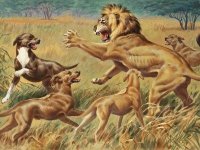The Rhodesian Ridgeback is a robust, muscular breed of dog, not a little one. Males are usually slightly smaller than females, standing between 25 and 27 inches (63 and 69 cm) at the shoulder and weighing about 85 pounds (38 kg). The characteristic "ridge" of hair on these dogs' backs, which develops in the opposite way from the rest of their coat, is what makes them so famous.
Originally originating in what is now Zimbabwe in Southern Africa, Rhodesian Ridgebacks were bred there. The Khoikhoi people created these, and European settlers later improved upon them. The breed served a variety of roles, such as guarding and hunting. Although the Rhodesian Ridgeback is frequently connected to its prowess in hunting lions,
It's critical to make clear the historical setting and the precise function they performed:
Hunting Lions: The Rhodesian Ridgeback was not bred to "fight" lions in the wild. Rather, they served as hunting dogs, helping hunters locate and deter lions until the hunters could get there. They were excellent at these activities because of their fearlessness, dexterity, and endurance.
Keeping Lions at Bay: During a hunt, the Rhodesian Ridgeback would approach a lion it had seen using its bravery and agility, which would divert and occupy it. The dog's task was to remain out of the way of the approaching hunters by using its speed and agility to avoid conflict.
Rhodesian Ridgebacks were used not just for hunting lions but also as security dogs to keep people and homesteads safe. They were useful at keeping predators and intruders at bay because of their loyalty and protective nature.
Although there is ample historical evidence supporting the employment of Rhodesian Ridgebacks for lion hunting, it is crucial to remember that these activities are not as common in modern times. Responsible breeders place a high value on temperament, health, and general well-being because these dogs are more frequently retained as family companions. Furthermore, hunting techniques have changed with time, and it is now typically frowned upon to use dogs to take on large predators.
Originally originating in what is now Zimbabwe in Southern Africa, Rhodesian Ridgebacks were bred there. The Khoikhoi people created these, and European settlers later improved upon them. The breed served a variety of roles, such as guarding and hunting. Although the Rhodesian Ridgeback is frequently connected to its prowess in hunting lions,
It's critical to make clear the historical setting and the precise function they performed:
Hunting Lions: The Rhodesian Ridgeback was not bred to "fight" lions in the wild. Rather, they served as hunting dogs, helping hunters locate and deter lions until the hunters could get there. They were excellent at these activities because of their fearlessness, dexterity, and endurance.
Keeping Lions at Bay: During a hunt, the Rhodesian Ridgeback would approach a lion it had seen using its bravery and agility, which would divert and occupy it. The dog's task was to remain out of the way of the approaching hunters by using its speed and agility to avoid conflict.
Rhodesian Ridgebacks were used not just for hunting lions but also as security dogs to keep people and homesteads safe. They were useful at keeping predators and intruders at bay because of their loyalty and protective nature.
Although there is ample historical evidence supporting the employment of Rhodesian Ridgebacks for lion hunting, it is crucial to remember that these activities are not as common in modern times. Responsible breeders place a high value on temperament, health, and general well-being because these dogs are more frequently retained as family companions. Furthermore, hunting techniques have changed with time, and it is now typically frowned upon to use dogs to take on large predators.




